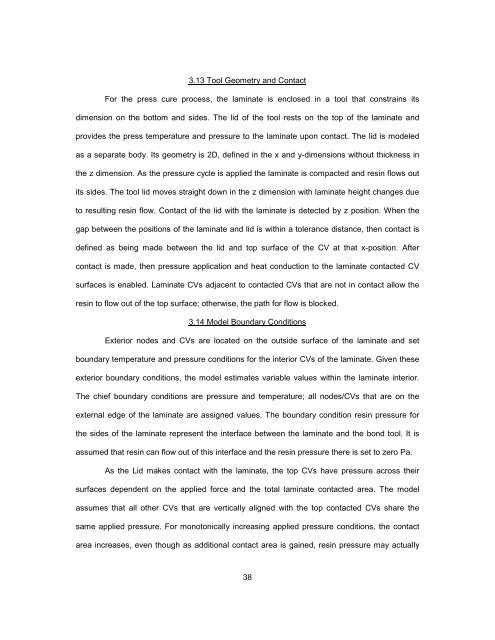TOOLED THICK COMPOSITES by ARVEN H. SAUNDERS III ...
TOOLED THICK COMPOSITES by ARVEN H. SAUNDERS III ...
TOOLED THICK COMPOSITES by ARVEN H. SAUNDERS III ...
You also want an ePaper? Increase the reach of your titles
YUMPU automatically turns print PDFs into web optimized ePapers that Google loves.
3.13 Tool Geometry and Contact<br />
For the press cure process, the laminate is enclosed in a tool that constrains its<br />
dimension on the bottom and sides. The lid of the tool rests on the top of the laminate and<br />
provides the press temperature and pressure to the laminate upon contact. The lid is modeled<br />
as a separate body. Its geometry is 2D, defined in the x and y-dimensions without thickness in<br />
the z dimension. As the pressure cycle is applied the laminate is compacted and resin flows out<br />
its sides. The tool lid moves straight down in the z dimension with laminate height changes due<br />
to resulting resin flow. Contact of the lid with the laminate is detected <strong>by</strong> z position. When the<br />
gap between the positions of the laminate and lid is within a tolerance distance, then contact is<br />
defined as being made between the lid and top surface of the CV at that x-position. After<br />
contact is made, then pressure application and heat conduction to the laminate contacted CV<br />
surfaces is enabled. Laminate CVs adjacent to contacted CVs that are not in contact allow the<br />
resin to flow out of the top surface; otherwise, the path for flow is blocked.<br />
3.14 Model Boundary Conditions<br />
Exterior nodes and CVs are located on the outside surface of the laminate and set<br />
boundary temperature and pressure conditions for the interior CVs of the laminate. Given these<br />
exterior boundary conditions, the model estimates variable values within the laminate interior.<br />
The chief boundary conditions are pressure and temperature; all nodes/CVs that are on the<br />
external edge of the laminate are assigned values. The boundary condition resin pressure for<br />
the sides of the laminate represent the interface between the laminate and the bond tool. It is<br />
assumed that resin can flow out of this interface and the resin pressure there is set to zero Pa.<br />
As the Lid makes contact with the laminate, the top CVs have pressure across their<br />
surfaces dependent on the applied force and the total laminate contacted area. The model<br />
assumes that all other CVs that are vertically aligned with the top contacted CVs share the<br />
same applied pressure. For monotonically increasing applied pressure conditions, the contact<br />
area increases, even though as additional contact area is gained, resin pressure may actually<br />
38
















